Refined Simulation Study on the Effect of Scour Environments on Local Scour of Tandem Bridge Piers
Abstract
:1. Introduction
2. Numerical Model
2.1. Hydraulics Model
2.1.1. Governing Equation
2.1.2. Turbulence Model
2.2. Riverbed Deformation Model
2.2.1. Sediment Incipient Motion
2.2.2. Sediment Transport
2.2.3. Sediment Scour Model
- Sediment entrainment and sedimentation calculation
- 2.
- Bed-load transport equation
3. Model Validation
3.1. Verification Conditions
3.2. Computational Domain and Grid Information
3.3. Numerical Solutions and Boundary Conditions
3.4. Validation Results
4. Characteristic Quantity Analysis
4.1. Pier-Side Vortex Effect
4.2. Bed Surface Shear Stress
5. Example Analysis
5.1. Scouring Terrain Feature Pattern
5.2. Scale Relationship of the Scour Hole Structure
5.3. Time Scale of Scouring Characteristics
6. Conclusions
- (1)
- The local scouring caused by ice cover contributes to the total scouring around the submerged pier within its coverage area, significantly increasing the depth and extent of the local scouring holes. For the local scouring under open-flow conditions, the sediment initiation is doubly inhibited and the hydrodynamic forces in the scouring holes are weakened; compared with the two types of scouring environments, the relative maximum equilibrium scouring depth under ice-cover conditions is 11% deeper than that under open-flow conditions, and the relative maximum scouring hole radius is widened by 5%.
- (2)
- The local scour simulation results show that the three-dimensional morphology of scour holes under two types of scour conditions are symmetrically similar, and the back row of piers is affected by the shading and reinforcement effect of the front row of piers. The development of scour holes around the piers lags behind that of the front row of piers, and the scour holes before and after the equilibrium stage are in a coherent shape, which is basically consistent with the shape of scour holes in the physical model test. This proves the reliability of the numerical simulation and the application of the present research in environmental and engineering aspects.
- (3)
- The transport of sediment particles in the scour hole is the cause of local scouring around the pier, whereas the interaction between the vortex and shear stress on the pier side is the main dynamic mechanism of scouring around the pier. The characteristic quantity analysis shows that the maximum mean vortex increase ratio of the vertical line is approximately 3% and the maximum shear stress increase ratio is approximately 6% under the ice-cover condition compared with the open-flow condition at the same time, and the two have a strong correlation, which helps to deepen the understanding of the scouring mechanism by quantifying the influence of the vortex and shear stress on the development of scouring holes.
- (4)
- The formula for calculating the scour depth is obtained by regression fitting on the basis of considering different scour environment factors, and is verified by using hydraulic model test data. This proves its reliability and accuracy and its suitability for the prediction of local scour depth of bridge piers in wide pier and shallow flow type riverbeds. It can be used as a reference application for the selected field prototype bridge piers.
- (5)
- Different scour forms in natural riverbeds often occur simultaneously and affect each other. This paper only simulated and analyzed the local scour of bridge piers under flat-bed conditions, and more numerical simulations may be conducted in the future to provide more solutions for the sustainable development of engineering environment, and thus, subsequent studies will focus on the coupling relationship between relevant characteristic quantities under sand-wave-bed scour conditions.
Author Contributions
Funding
Institutional Review Board Statement
Informed Consent Statement
Data Availability Statement
Conflicts of Interest
References
- Unger, J.; Hager, W.H. Down-flow and horseshoe vortex characteristics of sediment embedded bridge piers. Exp. Fluids 2006, 42, 1–19. [Google Scholar] [CrossRef] [Green Version]
- Dey, S.; Raikar, R.V. Characteristics of Horseshoe Vortex in Developing Scour Holes at Piers. J. Hydraul. Eng. 2007, 133, 399–413. [Google Scholar] [CrossRef]
- Wang, B.; Xu, Y.J.; Xu, W.; Cheng, H.; Chen, Z.; Zhang, W. Riverbed Changes of the Uppermost Atchafalaya River, USA—A Case Study of Channel Dynamics in Large Man-Controlled Alluvial River Confluences. Water 2020, 12, 2139. [Google Scholar] [CrossRef]
- Qi, M. Riverbed scouring around bridge piers in river section with sand pits. J. Hydraul. Eng. 2005, 36, 835–839. [Google Scholar] [CrossRef]
- Hu, H.; Wang, J.; Cheng, T.; Hou, Z.; Sui, J. Channel Bed Deformation and Ice Jam Evolution around Bridge Piers. Water 2022, 14, 1766. [Google Scholar] [CrossRef]
- Cheng, Z.; Koken, M.; Constantinescu, G. Approximate methodology to account for effects of coherent structures on sediment entrainment in RANS simulations with a movable bed and applications to pier scour. Adv. Water Resour. 2018, 120, 65–82. [Google Scholar] [CrossRef]
- Ettema, R.; Constantinescu, G.; Melville, B.W. Flow-Field Complexity and Design Estimation of Pier-Scour Depth: Sixty Years since Laursen and Toch. J. Hydraul. Eng. 2017, 143. [Google Scholar] [CrossRef]
- Qi, M.; Li, J.; Chen, Q. Comparison of existing equations for local scour at bridge piers: Parameter influence and validation. Nat. Hazards 2016, 82, 2089–2105. [Google Scholar] [CrossRef]
- Paik, J.; Ge, L.; Sotiropoulos, F. Toward the simulation of complex 3D shear flows using unsteady statistical turbulence models. Int. J. Heat Fluid Flow 2004, 25, 513–527. [Google Scholar] [CrossRef]
- Rodi, W. Turbulence Modeling and Simulation in Hydraulics: A Historical Review. J. Hydraul. Eng. 2017, 143. [Google Scholar] [CrossRef]
- Stoesser, T. Large-eddy simulation in hydraulics: Quo Vadis? J. Hydraul. Res. 2014, 52, 441–452. [Google Scholar] [CrossRef]
- Jia, Y.; Altinakar, M.; Guney, M.S. Three-dimensional numerical simulations of local scouring around bridge piers. J. Hydraul. Res. 2017, 56, 351–366. [Google Scholar] [CrossRef]
- Chen, S.-C.; Tfwala, S.; Wu, T.-Y.; Chan, H.-C.; Chou, H.-T. A Hooked-Collar for Bridge Piers Protection: Flow Fields and Scour. Water 2018, 10, 1251. [Google Scholar] [CrossRef] [Green Version]
- Yang, Y.; Qi, M.; Li, J.; Ma, X. Evolution of Hydrodynamic Characteristics with Scour Hole Developing around a Pile Group. Water 2018, 10, 1632. [Google Scholar] [CrossRef] [Green Version]
- Wu, P.; Balachandar, R.; Sui, J. Local Scour around Bridge Piers under Ice-Covered Conditions. J. Hydraul. Eng. 2016, 142. [Google Scholar] [CrossRef]
- Roulund, A.; Sumer, B.M.; Fredsøe, J.; Michelsen, J. Numerical and experimental investigation of flow and scour around a circular pile. J. Fluid Mech. 2005, 534, 351–401. [Google Scholar] [CrossRef]
- Burkow, M.; Griebel, M. A full three dimensional numerical simulation of the sediment transport and the scouring at a rectangular obstacle. Comput. Fluids 2016, 125, 1–10. [Google Scholar] [CrossRef]
- Dixen, M.; Sumer, B.M.; Fredsøe, J. Numerical and experimental investigation of flow and scour around a half-buried sphere. Coast. Eng. 2013, 73, 84–105. [Google Scholar] [CrossRef]
- Sui, J.; Wang, J.; He, Y.; Krol, F. Velocity profiles and incipient motion of frazil particles under ice cover. Int. J. Sediment Res. 2010, 25, 39–51. [Google Scholar] [CrossRef]
- Sabbagh-Yazdi, S.-R.; Bavandpour, M. Numerical experiments on using incline collar rings for controlling mean and fluctuating forces on circular bridge piers. J. Fluids Struct. 2019, 91. [Google Scholar] [CrossRef]
- Shi, H.; Yu, X.; Dalrymple, R.A. Development of a two-phase SPH model for sediment laden flows. Comput. Phys. Commun. 2017, 221, 259–272. [Google Scholar] [CrossRef]
- Tavakoli, S.; Khojasteh, D.; Haghani, M.; Hirdaris, S. A review on the progress and research directions of ocean engineering. Ocean Eng. 2023, 272. [Google Scholar] [CrossRef]
- Nagata, N.; Hosoda, T.; Nakato, T.; Muramoto, Y. Three-Dimensional Numerical Model for Flow and Bed Deformation around River Hydraulic Structures. J. Hydraul. Eng. 2005, 131, 1074–1087. [Google Scholar] [CrossRef]
- Olsen, N.R.B.; Skoglund, M. Three-dimensional numerical modeling of water and sediment flow in a sand trap. J. Hydraul. Res. 1994, 32, 833–844. [Google Scholar] [CrossRef]
- Zhu, Z.-W.; Liu, Z.-Q. CFD prediction of local scour hole around bridge piers. J. Cent. South Univ. 2012, 19, 273–281. [Google Scholar] [CrossRef]
- Jalal, H.K.; Hassan, W.H. Three-dimensional numerical simulation of local scour around circular bridge pier using Flow-3D software. IOP Conf. Ser. Mater. Sci. Eng. 2020, 745, 012150. [Google Scholar] [CrossRef]
- Dey, S. Threshold of sediment motion on combined transverse and longitudinal sloping beds. J. Hydraul. Res. 2010, 41, 405–415. [Google Scholar] [CrossRef]
- Soulsby, R.L. Dynamics of Marine Sand; Thomas Telford Publications: London, UK, 1997. [Google Scholar]
- Zhu, Z.; Liu, Z. Three-dimensional Numerical Simulation for Local Scour Around Cylindric Bridge Pier. China J. Highw. Transp. 2011, 24, 42–48. [Google Scholar] [CrossRef]
- Mastbergen, D.R.; Van Den Berg, J.H. Breaching in fine sands and the generation of sustained turbidity currents in submarine canyons. Sedimentology 2003, 50, 625–637. [Google Scholar] [CrossRef]
- Zhang, Q.; Zhou, X.-L.; Wang, J.-H. Numerical investigation of local scour around three adjacent piles with different arrangements under current. Ocean Eng. 2017, 142, 625–638. [Google Scholar] [CrossRef]
- Meyer-Peter, E. Formulas for bed-load transport. Proc Congr. Iahr 1948, 3, 39–64. [Google Scholar]
- Rijn, V.; Leo, C. Sediment Transport, Part I: Bed Load Transport. J. Hydraul. Eng. 1985, 110, 1431–1456. [Google Scholar] [CrossRef] [Green Version]
- Sang, L.; Wang, J.; Cheng, T.; Hou, Z.; Sui, J. Local Scour around Tandem Double Piers under an Ice Cover. Water 2022, 14, 1168. [Google Scholar] [CrossRef]
- Khaple, S.; Hanmaiahgari, P.R.; Gaudio, R.; Dey, S. Interference of an upstream pier on local scour at downstream piers. Acta Geophys. 2017, 65, 29–46. [Google Scholar] [CrossRef]
- Farooq, R.; Ghumman, A.R. Impact Assessment of Pier Shape and Modifications on Scouring around Bridge Pier. Water 2019, 11, 1761. [Google Scholar] [CrossRef] [Green Version]
- Tang, J.-H.; Puspasari, A.D. Numerical Simulation of Local Scour around Three Cylindrical Piles in a Tandem Arrangement. Water 2021, 13, 3623. [Google Scholar] [CrossRef]
- Williams, P.; Balachandar, R.; Bolisetti, T. Examination of Blockage Effects on the Progression of Local Scour around a Circular Cylinder. Water 2019, 11, 2631. [Google Scholar] [CrossRef] [Green Version]
- Valela, C.; Sirianni, D.A.B.; Nistor, I.; Rennie, C.D.; Almansour, H. Bridge Pier Scour under Ice Cover. Water 2021, 13, 536. [Google Scholar] [CrossRef]
- Chen, X.; Li, Y.; Niu, X.; Li, M.; Chen, D.; Yu, X. A general two-phase turbulent flow model applied to the study of sediment transport in open channels. Int. J. Multiph. Flow 2011, 37, 1099–1108. [Google Scholar] [CrossRef] [Green Version]
- Le Minor, M.; Bartzke, G.; Zimmer, M.; Gillis, L.; Helfer, V.; Huhn, K. Numerical modelling of hydraulics and sediment dynamics around mangrove seedlings: Implications for mangrove establishment and reforestation. Estuar. Coast. Shelf Sci. 2019, 217, 81–95. [Google Scholar] [CrossRef]
- Briaud, J.L.; Ting, F.C.K.; Chen, H.C.; Cao, Y.; Han, S.W.; Kwak, K.W. Erosion Function Apparatus for Scour Rate Predictions. J. Geotech. Geoenviron. Eng. 2001, 127, 105–113. [Google Scholar] [CrossRef]
- Buckingham, E. On Physically Similar Systems; Illustrations of the Use of Dimensional Equations. Phys. Rev. 1914, 4, 345–376. [Google Scholar] [CrossRef]
- Thompson, D.A.W. Galileo and the Principle of Similitude. Nature 1915, 95, 426–427. [Google Scholar] [CrossRef] [Green Version]
- Ettema, R.; Melville, B.W.; Barkdoll, B. Scale Effect in Pier-Scour Experiments. J. Hydraul. Eng. 1998, 124, 639–642. [Google Scholar] [CrossRef]
- Briaud, J.-L.; Ting, F.C.K.; Chen, H.C.; Gudavalli, R.; Perugu, S.; Wei, G. SRICOS: Prediction of Scour Rate in Cohesive Soils at Bridge Piers. J. Geotech. Geoenviron. Eng. 1999, 125, 237–246. [Google Scholar] [CrossRef]
- Cardoso, A.H.; Bettess, R. Effects of Time and Channel Geometry on Scour at Bridge Abutments. J. Hydraul. Eng. 1999, 125, 388–399. [Google Scholar] [CrossRef]
- Whitehouse, R.J.S.; Mitchener, H.J. Observations of the morphodynamic behaviour of an intertidal mudflat at different timescales. Geol. Soc. Lond. Spec. Publ. 2022, 139, 255–271. [Google Scholar] [CrossRef]
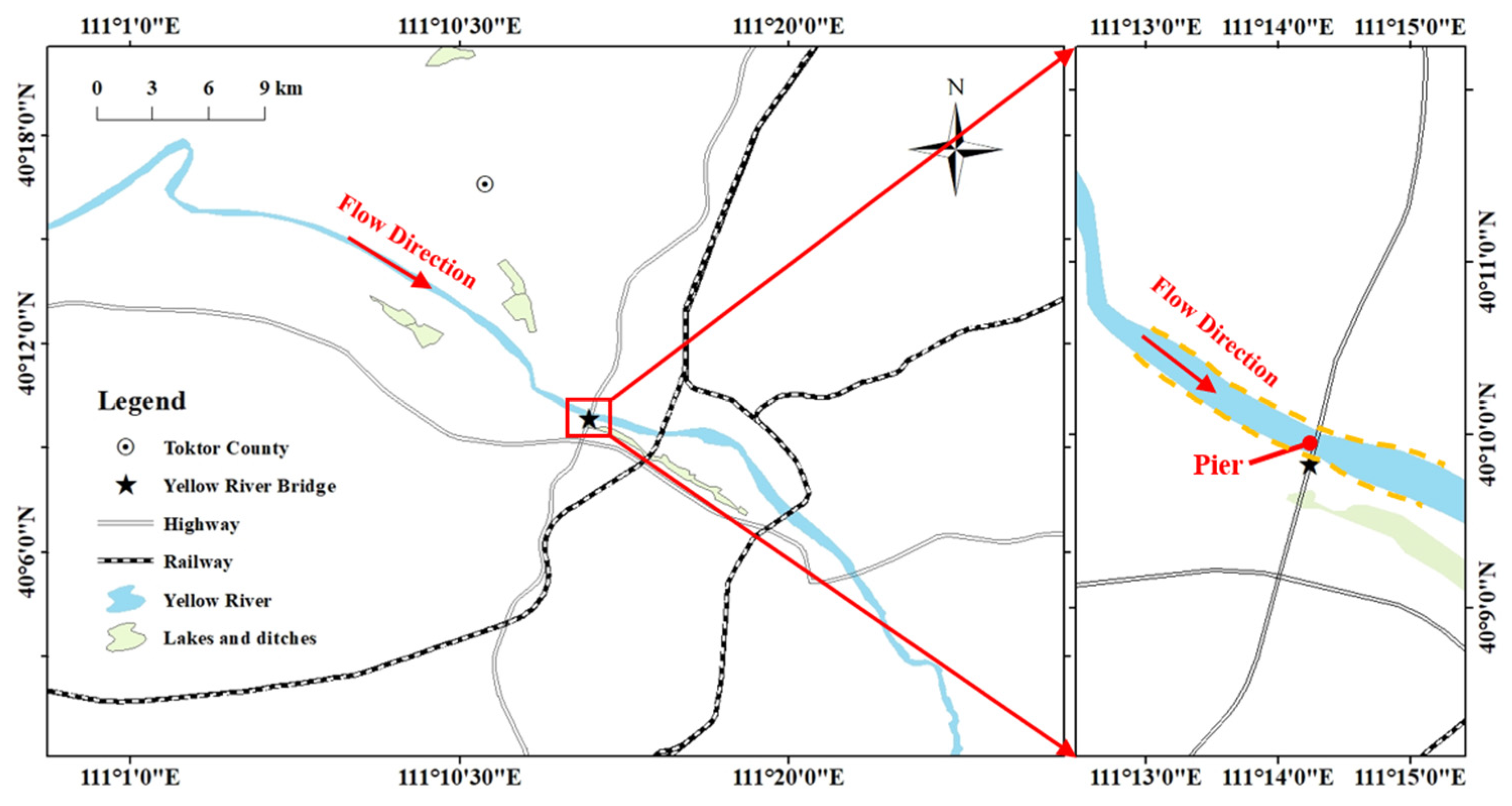
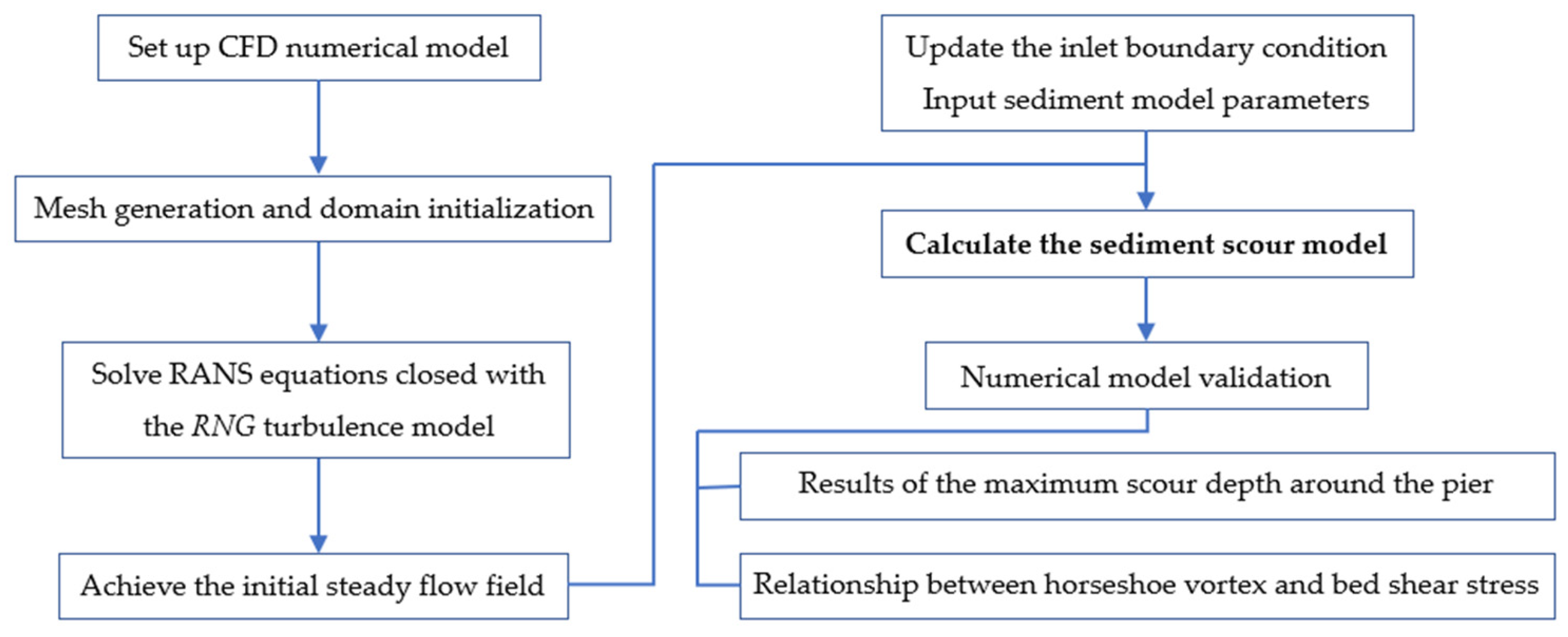
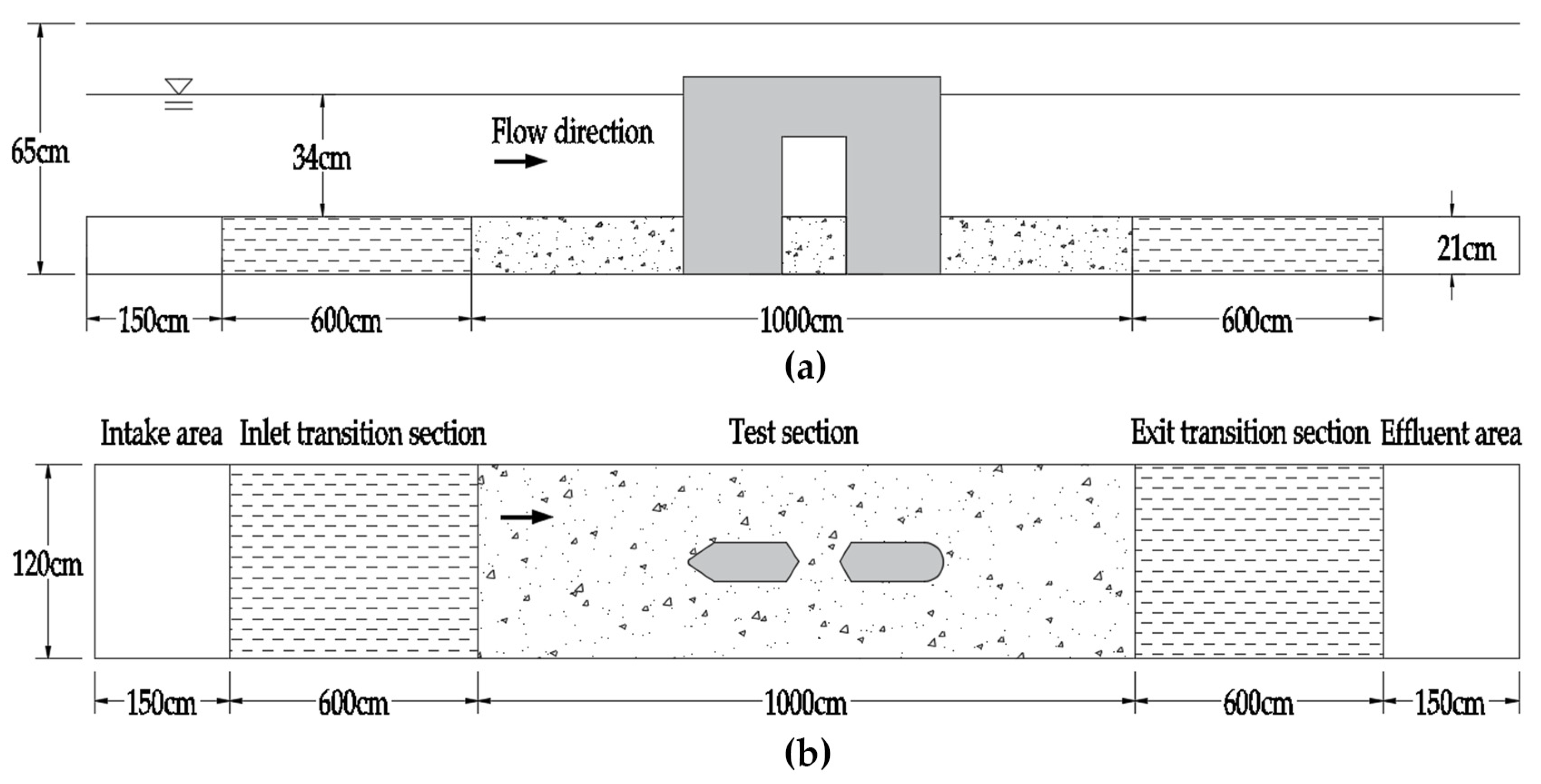
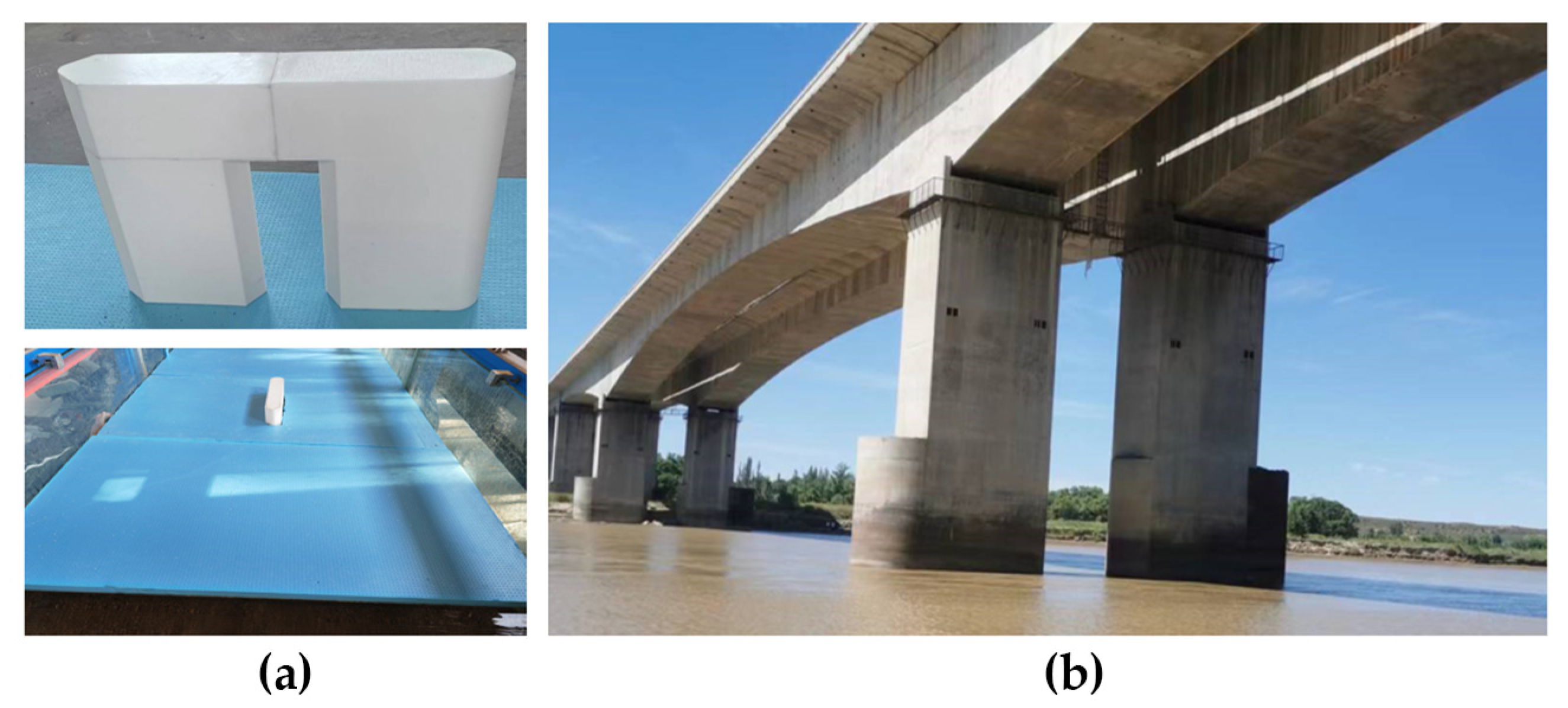







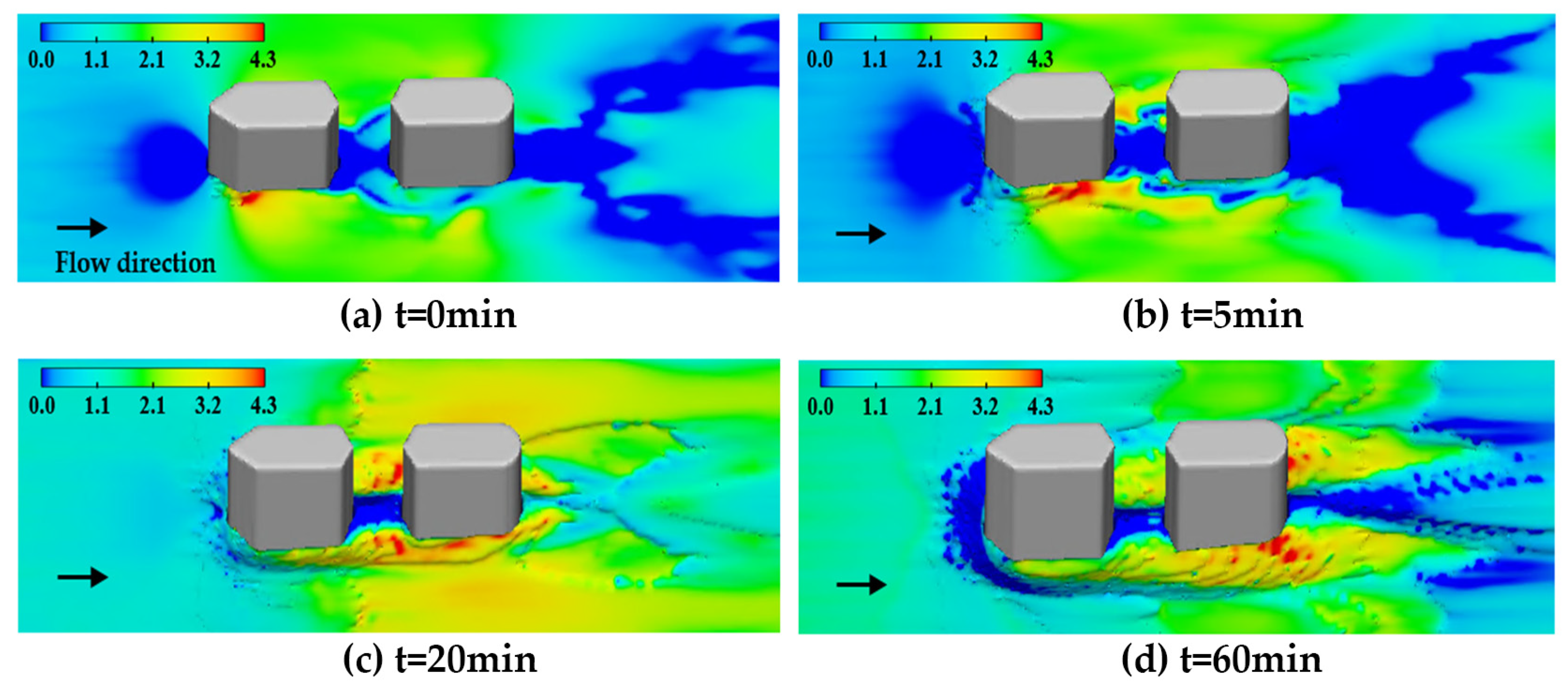

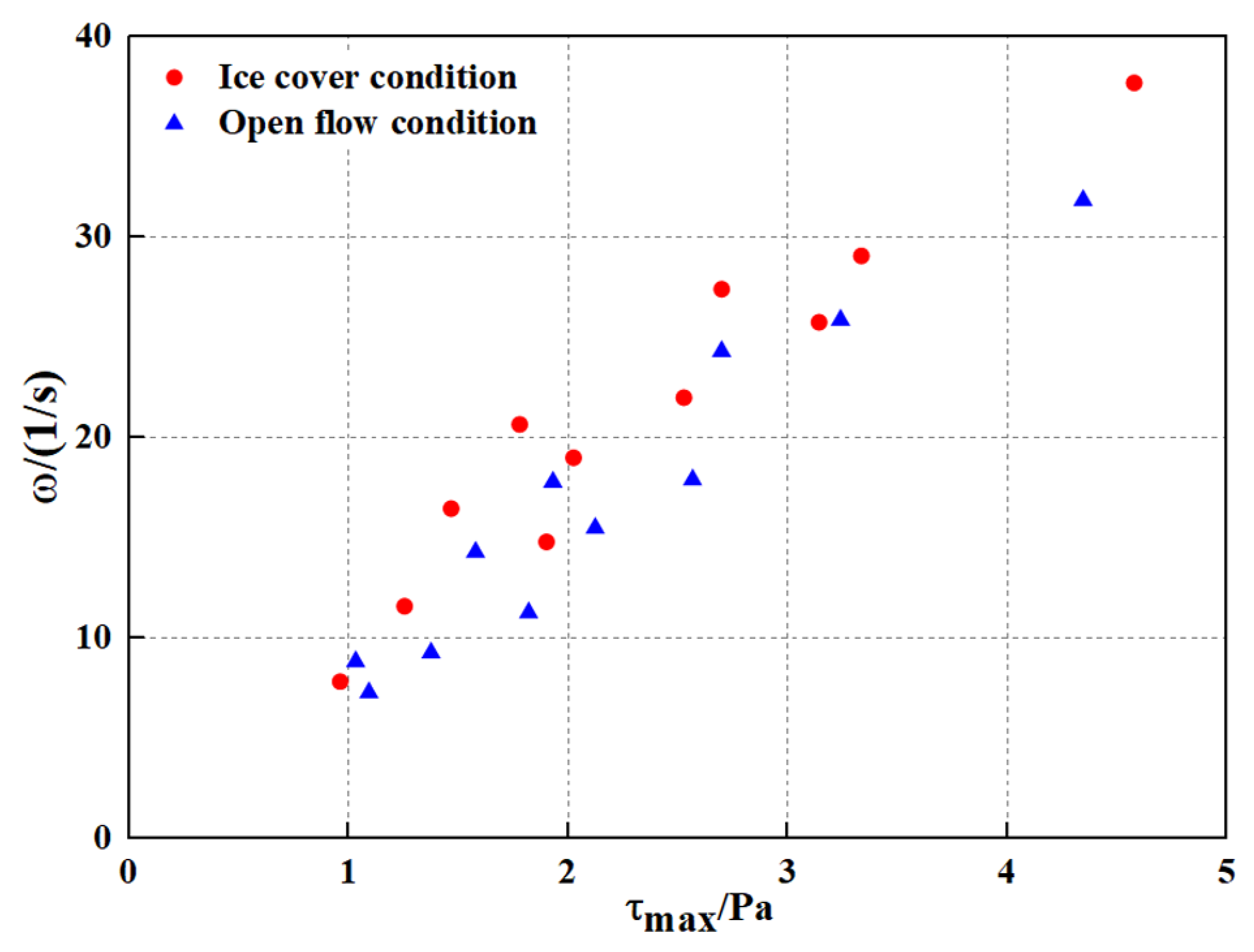
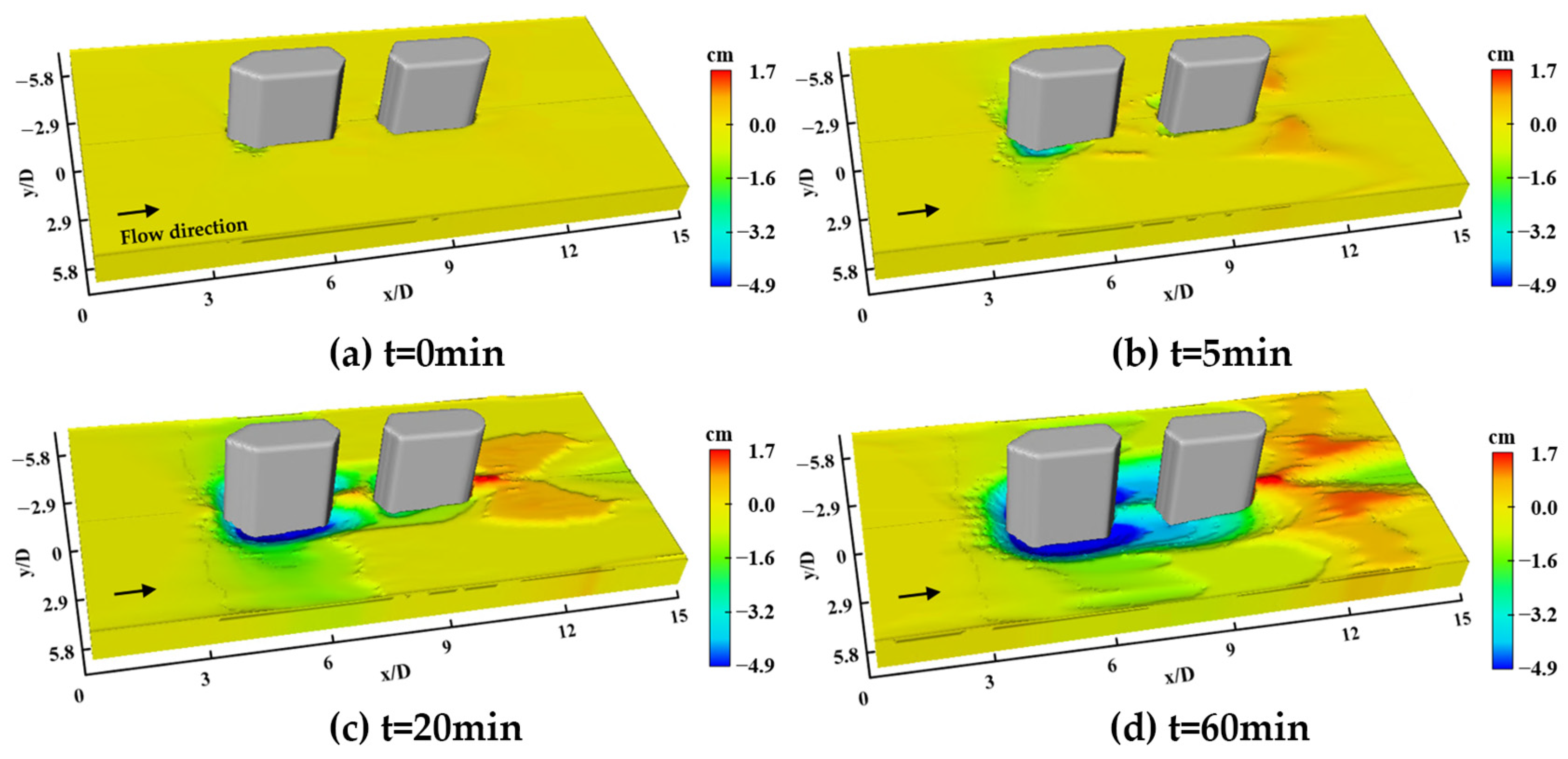
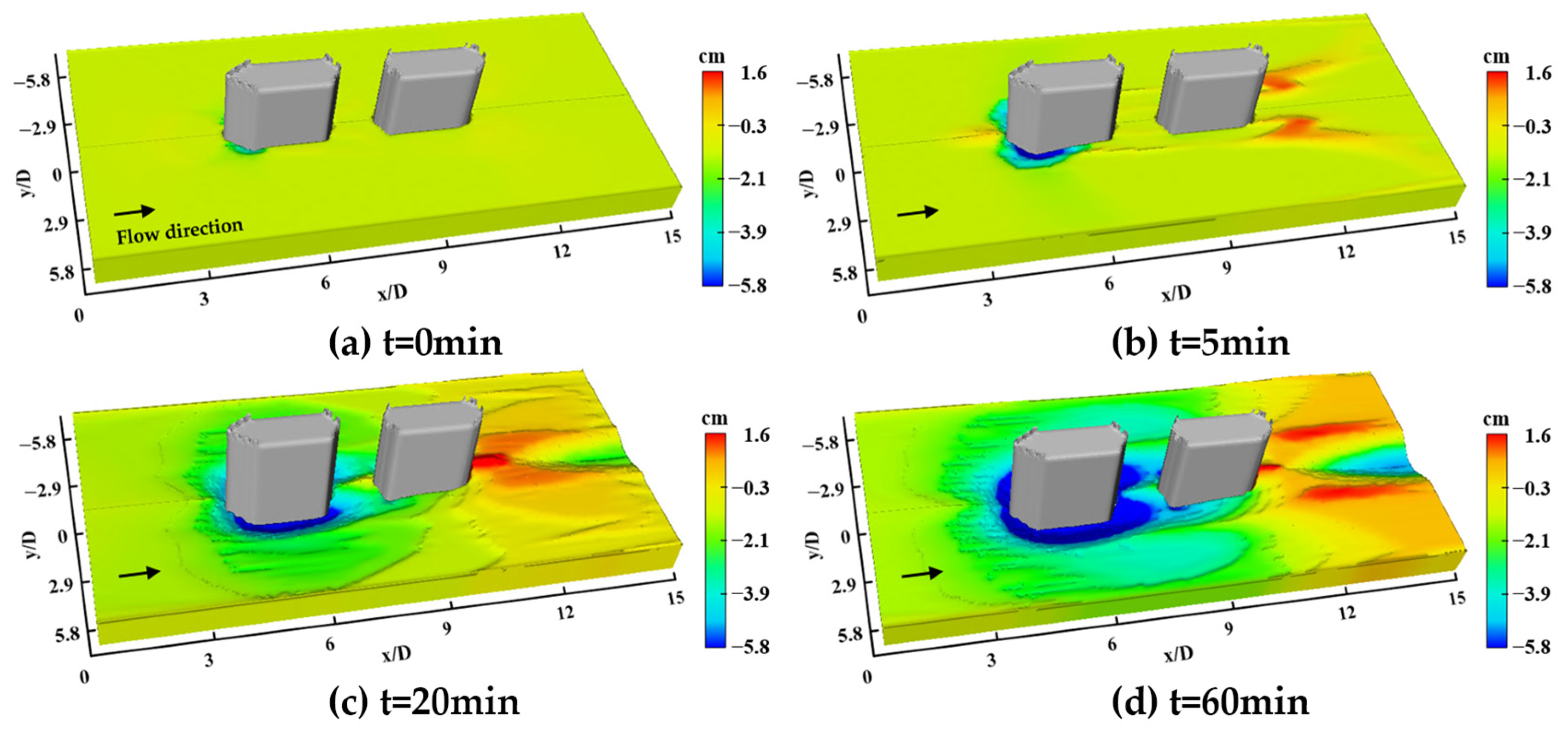

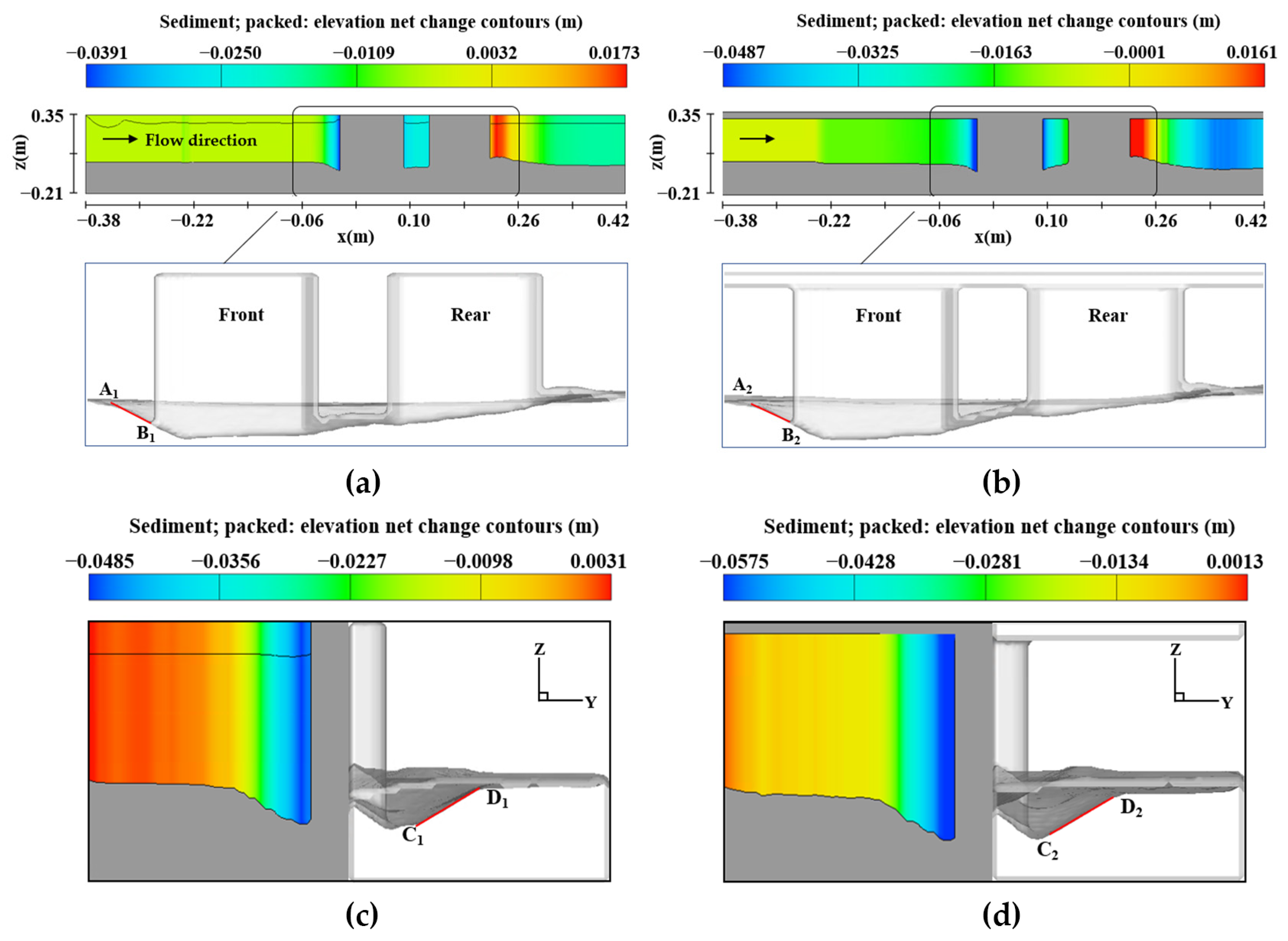
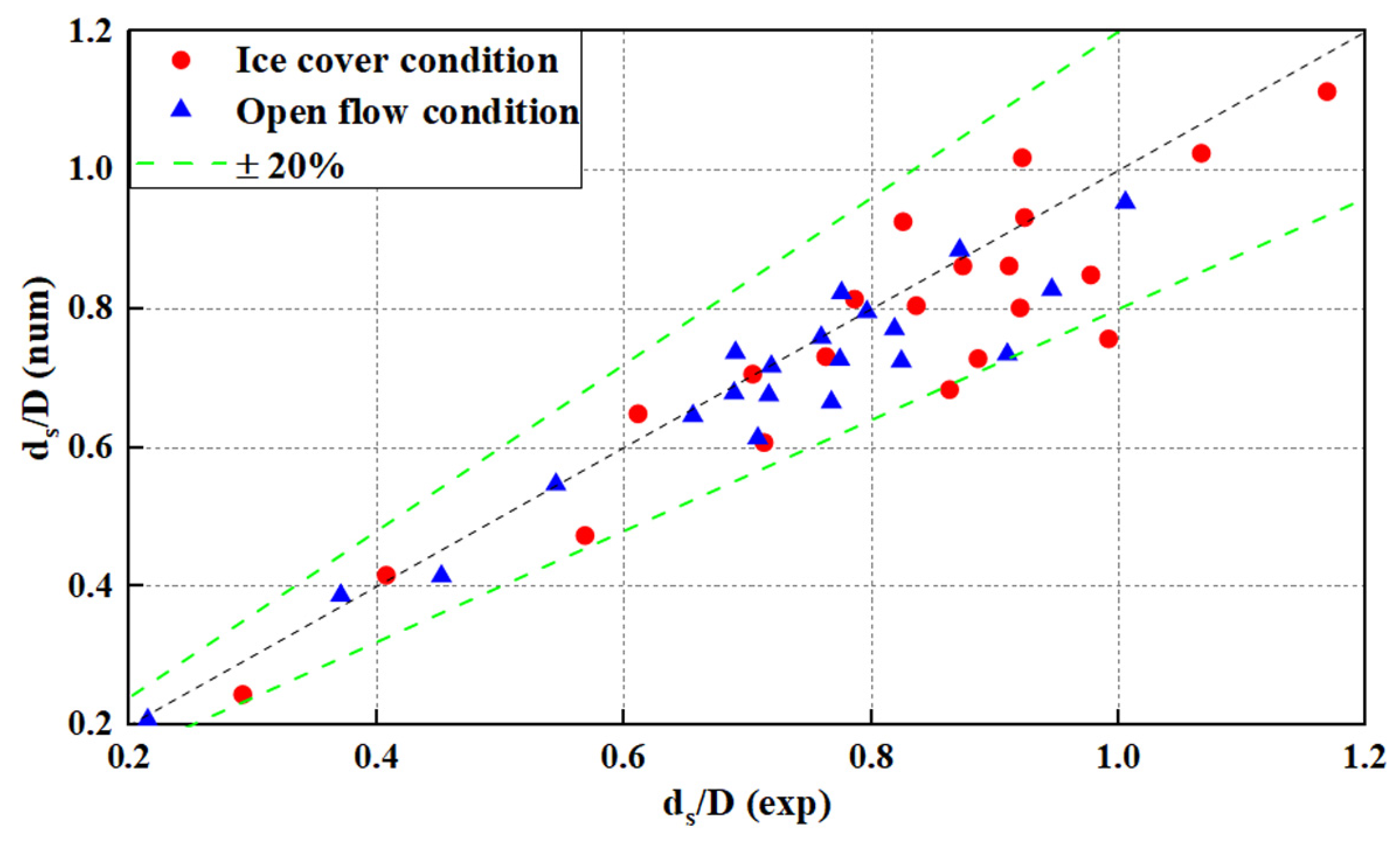
Disclaimer/Publisher’s Note: The statements, opinions and data contained in all publications are solely those of the individual author(s) and contributor(s) and not of MDPI and/or the editor(s). MDPI and/or the editor(s) disclaim responsibility for any injury to people or property resulting from any ideas, methods, instructions or products referred to in the content. |
© 2023 by the authors. Licensee MDPI, Basel, Switzerland. This article is an open access article distributed under the terms and conditions of the Creative Commons Attribution (CC BY) license (https://creativecommons.org/licenses/by/4.0/).
Share and Cite
Gao, P.; Mou, X.; Ji, H. Refined Simulation Study on the Effect of Scour Environments on Local Scour of Tandem Bridge Piers. Sustainability 2023, 15, 7171. https://doi.org/10.3390/su15097171
Gao P, Mou X, Ji H. Refined Simulation Study on the Effect of Scour Environments on Local Scour of Tandem Bridge Piers. Sustainability. 2023; 15(9):7171. https://doi.org/10.3390/su15097171
Chicago/Turabian StyleGao, Pengcheng, Xianyou Mou, and Honglan Ji. 2023. "Refined Simulation Study on the Effect of Scour Environments on Local Scour of Tandem Bridge Piers" Sustainability 15, no. 9: 7171. https://doi.org/10.3390/su15097171
APA StyleGao, P., Mou, X., & Ji, H. (2023). Refined Simulation Study on the Effect of Scour Environments on Local Scour of Tandem Bridge Piers. Sustainability, 15(9), 7171. https://doi.org/10.3390/su15097171





